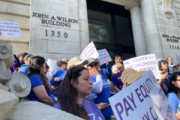Excerpts from recent editorials in the United States and abroad:
June 21
The Washington Post says it is crucial the White House stick up for what would be the FDA’s most assertive antismoking policy ever.
The Food and Drug Administration on Tuesday made a decision of rare importance, concerning not a pandemic illness but the country’s leading cause of preventable death: smoking. It is crucial the White House stick up for what would be the FDA’s most assertive antismoking policy ever — one that will inevitably meet severe resistance.
The agency is preparing a rule that would mandate that tobacco companies dramatically cut the amount of nicotine in cigarettes sold in the United States, rendering their deadly products minimally or not-at-all addictive. This move has long been anticipated: Congress in 2009 gave the FDA broad powers to regulate tobacco products. The agency started exploring this policy in 2017, and it should have used its authorities fully before now. It must move quickly. About half a million Americans a year die of smoking-related illnesses; any further delay would mean more unnecessary suffering and death.
The idea is to make cigarettes unattractive to people addicted to nicotine and to encourage them to get their fix in less dangerous ways — or simply to quit. While highly addictive, nicotine does not damage people’s bodies the way other chemicals in cigarette smoke do. If smokers could not extract large amounts of nicotine from cigarettes, they would turn to vaping or smoking-cessation products such as nicotine gum or patches. Some questions remain about vaping’s effects on health, but there is little serious doubt that it is a far less deadly alternative for chronic cigarette smokers. Meantime, anything that gets substantial numbers of people to quit tobacco entirely should be embraced.
Critics object that smokers would simply smoke a lot more cigarettes or inhale more deeply. But an FDA study published in the New England Journal of Medicine rebutted that concern, estimating that the smoking rate would plummet from 12.8% to 1.4 % by 2060. Some of this would come from product switching, some from people quitting and some from people not starting at all. By the end of the century, the number of new smokers would be reduced by 33.1 million, 8.5 million tobacco-related deaths would be averted, and 134.4 million life years would be gained.
Such an aggressive regulation might also create a black market for full-nicotine cigarettes, leading some to compare the policy to alcohol prohibition in the early 20th century. This is nonsense. Alternative nicotine delivery vehicles are pervasive. The FDA is not proposing to ban all nicotine products, just to discourage use of the deadliest. A massive, coordinated black market would have to form to put a substantial dent in the huge shifts in behavior the FDA projects. It would be of such a size and scope that federal authorities would easily be able to disrupt it.
To be sure, the FDA will have to write its regulations carefully so that smokers do not move en masse to other dangerous combustible tobacco products, such as cigars and pipe tobacco. Another danger is that smokers might add nicotine liquids to their cigarettes manually.
But the greatest risk is that resistance from industry and its ideological allies will derail the long rulemaking process to come. The agency should proceed with all possible speed, and the White House should stand by the rule as it works its way toward finalization.
ONLINE: https://www.washingtonpost.com/opinions/2022/06/21/fda-cigarette-nicotine-change-overdue/
___
June 18
The New York Times believes the world must come together to combat food shortages, inflation.
It is a natural human impulse, and a political one, to turn inward when threatened by a crisis that appears beyond our control. The world is facing several such forces at once: food shortages, inflation, the persistence of COVID-19 and the effects of global warming. Taken together, they threaten the stability and prosperity of nations around the world. That threat could hasten the retreat that many countries are already making away from globalization and international cooperation.
This is the wrong lesson to draw. COVID, climate change and now the specter of a global food crisis show clearly that the world’s problems are intimately linked, as are solutions. The power of cooperation has been on display in the coordinated response to Russia’s aggression. More cooperation, not less, is required to navigate a path forward through other crises.
That’s true even for inflation, an acute problem that Americans, like people in so many other countries, look to their national governments to solve. Inflation is higher than at any other time since the early 1980s, meaning that many people can’t afford to keep buying the same goods and services. Republicans have sought to put the blame for rising prices on the federal government, for overstimulating the domestic economy with relief funds in response to the pandemic, and economic analysts generally agree this has played a role.
The U.S. central bank, the Federal Reserve, which is charged with keeping inflation under control, was initially slow to respond. But it is now moving urgently to cool demand for goods and services by raising borrowing costs. On Wednesday, the Fed raised its benchmark interest rate by 0.75 percentage point, an unusually large jump.
High inflation in other developed economies underscores that the rise in prices is a global phenomenon, one that is caused in large part by global disruptions in the flow of oil, food and other goods. As the Fed squeezes demand, the Biden administration can ease the economic pain by working to expand the availability of goods and services. Some of the obstacles are domestic: America needs to get serious about building more housing, for example, the single largest expense for most American families.
Others are global: The White House needs to put its shoulder to the work of expanding the global production of energy, both through encouraging the near-term extraction of fossil fuels and by investing in the development of sustainable sources of energy. We also have called for President Biden to end his blanket tariffs on imports from China, a move the administration is reportedly considering.
The United States can help itself and the rest of the world by working with other nations — especially the countries in Africa, the Middle East and South Asia that are most at risk — to address a major impending food crisis. Shortages are already acute in parts of Africa, and some of the reasons are well known: the extreme weather of climate change, the economic ravages of COVID-19, the inequality of resources. But a new and devastating problem has been created by Russia’s cruel war on Ukraine.
Ukraine is the fourth-largest exporter of grain and seeds in the world, mostly corn and wheat, but with its ports either occupied or blockaded by Russia, its ability to ship its grain has been sharply reduced. It is essential to get the Ukrainian grain moving. Much of it normally goes to developing countries facing the worst food shortages, and Ukrainian silos have to be emptied to make room for grain about to be harvested.
Add a host of other war-related factors — sanctions on Belarus and Russia that have curbed the world’s supply of a key fertilizer, potash; granaries destroyed by Russian shelling; countries like India cutting off most wheat exports to make sure, understandably, that their own needs are met — and it becomes evident that Vladimir Putin’s war is having devastating repercussions on food supplies and prices far beyond Ukraine’s borders.
As is so often the case, it is the poorest countries that suffer the sharpest blow, and history shows that hunger can quickly turn lethal. Nigeria, Somalia, Ethiopia, Egypt and Yemen are already feeling the pain of food shortages, The Washington Post notes; rising prices have set off protests in Argentina, Indonesia, Tunisia and Sri Lanka, among other countries.
The largest constraint to the export of Ukrainian grain is the country’s inability to use its primary Black Sea port, Odesa. Ukraine has instead tried to ship its grain by road, rail and river, but these methods fall far short of what would be exported through Ukrainian ports. Before the Russian invasion, Ukraine was exporting an average of 3.5 million tons of grain per month. That fell to 300,000 tons in March and went up to a little over one million tons in April.
Odesa could handle the volume, and it is still under Ukrainian control. The problem is the warships and mines blocking shipping. Russia has indicated that it is prepared to open a secure channel out of Odesa, but it would expect the lifting of some sanctions in exchange. The United States and its allies have resisted lifting any sanctions; Ukrainians say Russia cannot be trusted.
Time is fast running out. The winter wheat is ripe, and about 25 million tons of grain, according to United Nations estimates, in Ukraine could rot if it isn’t exported soon. Even an immediate agreement to clear the way to Odesa would require weeks to arrange a large flotilla willing to take the risk of entering a war zone and pay for the necessary insurance and escort. Using NATO ships could create the danger of a direct confrontation with Russian warships, which the Western allies have been intent on avoiding.
The U.N. secretary general, António Guterres, has said that “there is no effective solution to the food crisis without reintegrating Ukraine’s food production, as well as the food and fertilizer produced by Russia and Belarus, into world markets, despite the war.” He suggested, in effect, that the United States and Europe relax the existing sanctions on Russian and Belarusian agriculture exports in exchange for letting Ukrainian grain flow unimpeded to the world.
There is merit in trying to put world food supplies above the exigencies of conflict, but easing the sanctions that Russia is demanding — those imposed on Russian exports and financial transactions, as a Russian deputy foreign minister, Andrei Rudenko, said on state media — would mean giving in to Russia’s aggression and attempt at humanitarian blackmail.
What might yet work is a joint appeal to Mr. Putin by the countries that stand to be most affected by the food crisis. Mr. Putin has met separately with the leaders of Turkey, Israel and the African Union, among others, and has insisted publicly that responsibility for the emerging global food and energy crises falls entirely on Western greed and Western sanctions. He repeated that message forcefully in a speech on Friday at the St. Petersburg International Economic Forum, blaming the United States for the world’s instability.
But he may find it harder to brush off an appeal from nations that are threatened by hunger, especially those that have so far resisted Western pressures to join in the ostracism of Russia. The United States should encourage and support such an appeal, which would get these countries involved in a way that serves their critical interests. And if an appeal includes a proposal to provide an escort of ships flying Ukrainian flags, Ukraine might feel less distrustful.
International trust and cooperation are in desperately short supply, but it’s the only way out of any of these intertwined crises. The Biden administration should see this moment as a critical one for America’s leadership in the world, and step up to meet it.
ONLINE: https://www.nytimes.com/2022/06/18/opinion/inflation-global-food-shortage-ukraine.html
___
June 19
The Wall Street Journal says Democrats are finally recognizing the Joe Biden is too old for the office of the presidency.
A pastime around our office in early 2021 was guessing when Democrats would begin to point out that President Biden was too old for the job and should pack it in. The consensus was after a drubbing in the midterm election, but congrats to the colleague (he knows who he is) who figured sometime early this year. He wins the office pool because the drive to shove the President out the door has already begun.
The New York Times kicked off the kicking with a story quoting various progressive sages suddenly admitting what everyone has known all along: Mr. Biden is the oldest serving U.S. President at age 79, and he’ll be 82 when he finishes his term. He looks and sounds every bit his age. This declaration of the obvious has now moved along the progressive media chorus line to the Atlantic, with a piece that asserts “Let me put this bluntly: Joe Biden should not run for re-election in 2024. He is too old.”
These stories treat this as a revelation, as if Mr. Biden suddenly showed some dramatic decline. The truth is that the President demonstrated he had lost a verbal, and maybe mental, step in the first Democratic candidate debate in 2019. He hasn’t improved. Democrats admitted it privately at the time, but they rallied to him during the South Carolina primary when it looked like he was the only Democrat who could hold off the nomination of Bernie Sanders and defeat Donald Trump.
The rest of the campaign was a long apologia for Mr. Biden’s strategy of limiting his public exposure by campaigning in his Delaware basement. Covid-19 was the perfect excuse, and woe to any journalist who dared to ask if Mr. Biden wasn’t the same man we knew as Vice President. The subject was taboo.
This was one of the great free campaign passes in history. Ronald Reagan’s age was a subject of agonized media concern when he ran for President at age 69 in 1980. He was roasted after he stumbled in the first debate against Walter Mondale in 1984, and he had to defuse the media and public doubts with a quip about Mondale’s “youth and inexperience” in the next debate.
The Gipper was three weeks shy of 78 when he left office, which was younger than Mr. Biden was when he entered the Oval. If the President runs and serves a second term, he’d be 86 on his final day in the job. But Mr. Biden was needed to defeat Mr. Trump, and so all of this age business had to be ignored in 2020.
Why the Democratic turn now? One obvious answer is that the President is down in the polls, and his low approval rating may cost Democrats control of Congress in November. The problem can’t be the party’s ideas, or Mr. Biden’s adoption of the Sanders agenda after he’d campaigned as a moderate. The problem has to be Mr. Biden. He’s suddenly not up to the burdens of the Oval Office that have aged even younger men. He can’t make the case for his ideas. He’s overwhelmed by crises.
You almost have to feel sorry for Mr. Biden, who saved his party from Mr. Trump but is expendable now that he’s a political liability. You can almost hear Mr. Biden shouting at his staff: Where’s the gratitude? You think Bernie or Mayor Pete would have beaten Trump? I’m the guy who saved democracy.
Mr. Biden can be stubborn, and as anyone with older parents knows, taking away their car keys can be a difficult conversation. The President may not want to leave town as easily as some Democrats want him to.
All the more given the lack of obvious Democratic alternatives to Mr. Biden in 2024. Vice President Kamala Harris would run in a millisecond, but nothing she has done or said since her emergence on the national scene suggests she is up to the Presidency.
Democrats know this, which you can tell by all the stories earlier this year about her political struggles. That’s the Beltway insider way of preparing the field for other candidates to consider running. Not that Pete Buttigieg will need any coaxing.
Such is the price of nominating Mr. Biden with so little scrutiny about his capacity for the Presidency. Perhaps Democrats will avoid a drubbing in the midterms, or he’ll rally after the election by using a GOP Congress as a foil. But Democrats may want to begin looking for candidates far from Washington if they want to retain the White House in 2024.
ONLINE: https://www.wsj.com/articles/breaking-the-joe-biden-age-taboo-media-democrats-kamala-harris-2024-election-11655504661
___
June 21
The Los Angeles Times argues that the death penalty is wrong — even for racist mass killers.
A judge has asked federal prosecutors whether they will seek the death penalty against the white man accused in the killing of 10 Black people in Buffalo, NY, on May 14.
Their answer should be easy: no.
President Biden promised to eliminate federal capital punishment and to encourage states to do the same. His attorney general, Merrick Garland, has said the U.S. should return to the virtual moratorium on federal executions that began in 2003 and ended with 13 people being put to death in the final six months of the Trump administration (nearly half of those executions took place after the 2020 election).
But instead of simply saying no, the prosecutor in the hate crimes and firearms case against 18-year-old Payton Gendron told U.S. Magistrate Judge H. Kenneth Schroeder, Jr. he would pass the request for a response to Garland. There has been no answer yet, supposedly because prosecutors have procedures to follow, such as conferring with the victims’ families.
But it’s just as likely that the administration is waffling because of the heinousness of the act of which Gendron is accused.
If there are crimes that could give even the most stalwart death penalty opponents pause, the Buffalo massacre would surely be among them. Gendron, who has pleaded not guilty, is reported to have traveled more than 200 miles from his home to a supermarket in a predominantly Black part of the city, where he allegedly shot 13 people, 10 of them fatally.
Police have said he was armed for combat, and that he said he acted out of racial hatred. He reportedly studied other racist mass killings and wrote a manifesto citing the so-called “great replacement” conspiracy theory that contends people of color are being imported to the U.S. to diminish the power of white people.
This depraved act of racism and paranoia adds to strains on an American society already racked by mass shootings, political discord, racial tension, economic uncertainty and a historic pandemic.
The particulars of the Buffalo case — a horrendous act of racial terrorism — test the principles of justice. Yet seeking to execute Gendron would be to answer immorality with a moral wrong.
The perpetrators of most massacres of this order generally spare the public soul-searching over the death penalty because they rarely survive their attacks, as is most likely part of their wretched plans. Few tears would probably have been shed for Gendron if police had shot him dead in the midst of the shooting, instead of talking him into surrendering.
When the killer is apprehended, though, the killing should end. The punishment for the crime should have nothing to do with what the killer “deserves” or with mercy. Mass murderers may or may not feel they are being shown mercy when they are locked up for the remainder of their lives, but their position on the subject is of little account. State and federal punishments should not include execution because judicial killing has no place in a civilized society.
The state of New York appears to understand that. It has a death penalty statute on its books, but the law was ruled unconstitutional in 2004, and the state has chosen to take no steps to restore capital punishment. It has commuted all remaining death sentences and dismantled all execution equipment and facilities. Gendron faces life without parole in New York state prison, not execution.
But he does face the death penalty under parallel federal prosecution for hate crime and murder-with-firearms charges. It’s not yet clear whether the state or federal trial would proceed first, but the federal judge said he wants an answer quickly on the death penalty because seeking it means more costly procedures, and taxpayers’ money should be protected. Hence the question for Garland, who must decide, and Biden, who promised to end federal capital punishment.
They faced a similar situation last year with one of the Boston marathon bombing perpetrators, whose death sentence was struck down by an appeals court. The administration responded poorly, appealing to the Supreme Court to reinstate the sentence — and winning — while also sticking to its position against executions. Either it supports the death penalty or it doesn’t.
It shouldn’t. Not even for terrorists like the Boston bomber or the Buffalo shooter. If the death penalty is wrong — and it is — it is wrong for everyone.
ONLINE: https://www.latimes.com/opinion/story/2022-06-21/buffalo-shooting-death-penalty
___
June 16
The Guardian says the killing of Dom Phillips and Bruno Pereira in the Amazon is the embodiment of a wider assault on environmental defenders.
The killing of Dom Phillips and Bruno Pereira in the Amazon is devastating for their families and friends. It is also the embodiment of a wider assault on environmental defenders and those who work with them, and of the dangers faced by journalists. The relentless targeting of those who seek to protect an ever more fragile world is increasing as the climate crisis grows more intense. In 2020, more than four defenders a week died globally. A disproportionate number are Indigenous people or, like Mr. Pereira, those who work closely with and for them. Mr. Phillips, though passionate about the environment, was not an activist but a reporter – one of many who have died in Latin America because of their work.
The discovery of their bodies, and the police announcement that one of the suspects arrested in connection with their disappearance has said that he killed them, brings an end to the families’ anguish of not knowing their whereabouts. “Now we can bring them home and say goodbye with love. Today, we also begin our quest for justice,” Mr. Phillips’ widow, Alessandra Sampaio, wrote in a statement.
Brazilian authorities were slow to mount a proper search for the journalist and the Indigenous advocate, and to launch a criminal investigation; it was Indigenous people who led the way. It is reassuring that a suspect is now in custody and has, reportedly, confessed. But it is essential that the investigation continues, that the facts are fully established and that those responsible are held accountable. The government should send a clear message about this case’s importance.
Yet the country’s president, Jair Bolsonaro, has, while saying that something “wicked” happened, also callously cast blame on the two men. In contrast, Brazilians have shown immense sympathy to them and their families, understanding that their work benefited Indigenous people, Brazilians as a whole and the wider world. It was just not in the interests of a state that has been captured by extractivist interests and disdains the rule of law, creating a culture of impunity for those exploiting the Amazon rainforest and making its protectors far more vulnerable.
Brazil is one of the most dangerous countries for land and environmental defenders, with 20 having died in 2020, according to the watchdog Global Witness, which warns that killings are rising across the global south. Colombia saw 65 murders that year; Mexico another 30; and there were 29 in the Philippines where, as in Brazil, an authoritarian president has dismissed human rights and environmental concerns and embraced corporate interests. The power of corporations has not only driven the environmental crisis but also the violence against those seeking to tackle it. As Global Witness notes, it is rare that anyone is arrested or prosecuted for killing defenders – and when they are, it is usually those who pull the trigger, not those who might be implicated, directly or indirectly.
Businesses and governments too must be held accountable for such violence. Ensuring justice for Mr. Phillips and Mr. Pereira is necessary not only to honor their lives and work but also to protect the lives of others and to defend the environment that they cherished.
ONLINE: https://www.theguardian.com/commentisfree/2022/jun/16/the-guardian-view-on-dom-phillips-and-bruno-pereira-justice-for-them-safety-for-others
END
Copyright © 2024 The Associated Press. All rights reserved. This material may not be published, broadcast, written or redistributed.







